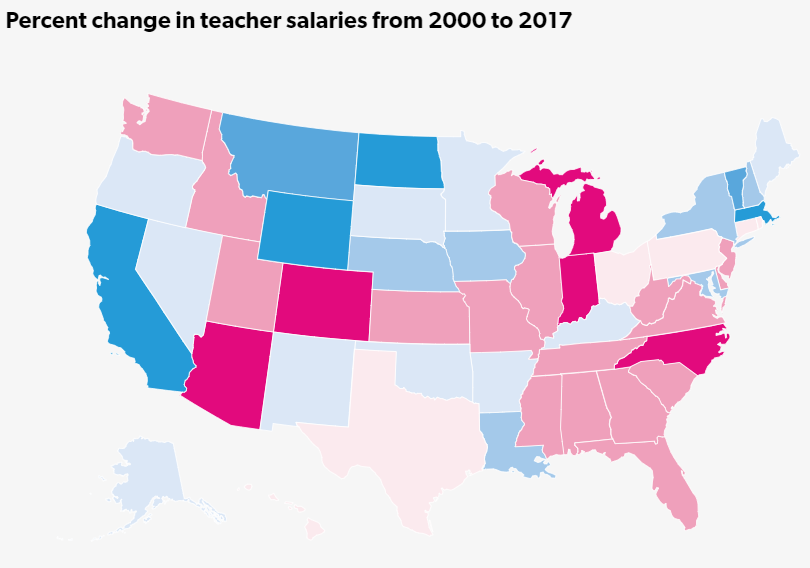Education
In 32 states, teacher salaries have not kept pace with inflation

The Biden Administration passed an executive order at the start of 2021 to support the reopening and continued operation of in-person schooling. The order instructed the Department of Education and the Department of Health and Human Services to assist states, elementary schools, and secondary schools in safely reopening for in-person education to children across the country.
In March, President Joe Biden passed the $1.9 trillion American Rescue Plan, allocating $170 billion to K-12 schools and colleges. The plan helped fund initiatives for schools to hire more staff, buy personal protective equipment for teachers, staff, and students, add ventilation systems in schools, reduce class sizes and implement social distancing.
Although it is too early to know the pandemic’s full impact on student learning, data from the Education Department and from the Household Pulse survey gives insight into student learning experiences over the last year.
Last May, most fourth graders had four hours or less of live instruction per day during remote learning, according to a Department of Education survey.[1] The survey tracked the mode of instruction offered by schools during the COVID-19 pandemic between January and May 2021. Participating schools reported how many hours of live instruction students received daily, plus attendance rates for each instructional mode and which student groups were prioritized for in-person learning.
According to the survey, 43% of fourth graders started 2021 in remote learning. By May, that figured dropped to 24%. The numbers showed a similar trend for eighth graders, with about half in remote learning to start the year and about 30% ending the year remotely. By the end of the 2020-2021 school year, almost all schools in the survey offered either hybrid or full time in-person learning opportunities for its fourth and eighth graders, compared to only three-quarters of schools offering the same programs in January.
White students were learning in-person at the highest rates of any race or ethnicity group in the 2020-21 school year. In January, half of all fourth graders attending in-person school were white. By May, that rose to 66%. The pattern was similar for white eighth-grade students.
Fifty-one percent of Asian eighth-grade students were in remote learning by May 2021, tops of any other race or ethnicity group. Black and Native Hawaiian or Pacific Islander students were the next highest group for remote learning with both at 35% as of May. The pattern was similar for fourth-grade students.
For all race or ethnicity groups, between 20 to 29% of fourth-grade students were in a mix of in-person and virtual learning by the end of the school year.
Data regarding the impact COVID-19 had on student test scores is not yet available.
The Household Pulse Survey[2] asked adults living in households with K-12 students how the pandemic impacted children’s education last school year.
The survey found that in mid-April, about half of households had students in virtual school receiving instruction from a teacher in real-time versus half receiving in-person instruction. For students in virtual classes, about 42% used online or paper materials provided by their school, with 8% using their own materials.
Sixty-one percent of children living in households with incomes below $25,000 were learning virtually compared to 51% of children in households with incomes above $100,000.
The Education Department expected all schools to give students the option to return to full-time, in-person instruction during the 2021-2022 school year. States asked school districts to rely on recommendations from local health departments and from the Centers for Disease Control and Prevention (CDC) on mask-wearing, social distancing and other COVID-19 precautions. Colorado and Virginia have remote and hybrid learning options. At least 17 other states offer remote learning for those who want it, according to the Office of Elementary and Secondary Education.
There is no overarching federal plan to keep all public schools in-person full-time this school year. In most states, decisions on when to move learning to a virtual or hybrid model due to a COVID-19 outbreak are left up to individual school districts.
Although national data on K-12 public school enrollment numbers for fall 2021 are not yet available, the national school enrollment rate fell by 3% in the first full school year of the pandemic, according to preliminary data from the National Center for Education Statistics. Vermont, Mississippi and Washington had the largest drops in enrollment rates. Preschool and kindergarten enrollment decreased by 13% nationwide. Between fall 2009 and fall 2018, K-12 enrollment numbers increased by nearly 3%.
Learn more about education in the US.
To learn more about K-12 school enrollment, see USAFacts’ K-12 education metrics.
The School Survey Dashboard was created as part of a pilot study to provide data for understanding learning opportunities offered by schools during the COVID-19 pandemic. Forty-six states/jurisdictions participated in the survey.
The Household Pulse Survey represents a subsection of the population. Totals may not sum to 100% because the survey question allowed for multiple categories to be marked.